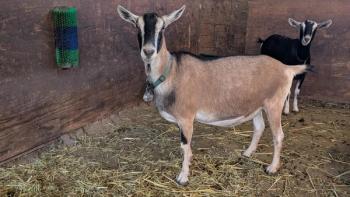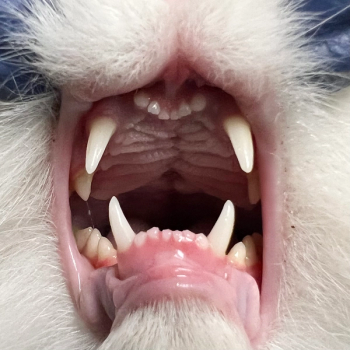
Intra-articular injections for management of canine arthritis--high tech therapy for general practice (Proceedings)
Juvenile pubic symphysiodesis: a simple, affordable surgical solution to canine hip dysplasia.
Juvenile pubic symphysiodesis: a simple, affordable surgical solution to canine hip dysplasia.
Lameness and pain caused by osteoarthritis (OA) is one of the most common presenting complaints in small animal practice. Despite a plethora of pharmaceutical, neutraceutical and nutritional interventions treatment failure and chronic discomfort are frequent. Intra-articular injection of a variety of anti-inflammatory and joint-protective substances offers a simple, practical, affordable and often highly successful method to treat debilitating osteoarthritis in dogs.
This lecture will teach small animal practitioners the principles and easy methods of IA injection. Specific topics will include IA injection of corticosteroids, glucosamine/chondroitin/hyaluronic acid, interleukin-1 receptor antagonist protein (IRAP), autologous conditioned plasma (ACP), and stem cells.
Method of intra-articular injection
To perform intra-articular injection, heavy sedation is required. I prefer a combination of dexdomitor and butorphanol, but other methods are certainly acceptable. The bottom line is that an immobile, pain-free patient is required. Surgical preparation of the site should be performed, and the clinician should wear sterile gloves. The joint is entered with an appropriate sized needle attached to a syringe, and correct placement confirmed by aspiration of joint fluid. Fluid can be submitted for analysis if indicated. While the needle is maintained in the joint, the syringe is replaced with a 2nd syringe loaded with drug to be injected. Injection should be smooth and without resistance. It is helpful to have an anatomic model present for reference when first performing joint injections. These can be obtained from several biological supply companies online.
Injection of specific joints
Table 1: Injection technique for specific joints in the dog Joint Limb Position Needle (30 kg dog) Syringe (30 kg dog) Technique Alternate Technique Stifle Gentle flexion 20 g 3 cc Midway between patella and tibial ruberosity Parallel to patella Elbow Neutral 20-22 g 3 cc Midway between olecranon and lateral epicondyle Midway between olecranon and lateral epicondyle Hock Neutral 22 g 3 cc Cranial in palpable depression between tibia and talus Caudal with limb hyperextended just medial to lateral malleolus Carpus 90 degree flexion 22-25 g 1-3 cc Cranial in palpable depression between radius and radiocarpal bone Shoulder Neutral with traction 20 g long 3 cc Directly distal to acromion a distance estimated from radiograph Between greater tubercle and acromion from cranial to caudal Hip Neutral with traction 20 g long 3 cc Cranial to greater trochanter perpendicular to limb Medial adjacent to pectineus
Stifle
The stifle is probably the easiest joint to inject, so clinicians may want to select a case of stifle OA for their first attempt with IA injection. The stifle is placed is gentle flexion, and the patella and tibial tuberosity are palpated. The needle is started either medial or lateral to the patellar tendon, and directed at an angle that bisects the angle being formed by the femur and tibia (i.e. the stifle angle). In cases of severe OA joint fluid may be difficult to obtain with this technique. An alternate technique is to start the needle at the proximal or distal aspect of the patella, and direct the needle parallel to the joint surface rather than perpendicular to it.
Elbow
The elbow joint is very frequently affected with chronic OA, usually secondary to canine elbow dysplasia. The elbow can be injected from either the medial or lateral side. For a lateral injection, the patient is placed in lateral recumbency with the affected limb up and the joint placed in a neutral position. The olecranon and the lateral epicondyle of the humerus are palpated. The needle is started midway between these two points, and directed into the caudal aspect of the joint. A medial injection is the same, except that the affected limb is placed down, and the medial epicondyle is used as a landmark. It is sometimes useful to place a towel under the joint to be injected, and have an assistant lever the joint open by pushing the paw down towards the table.
Hock
Relative difficulty of hock injection depends on the amount of effusion present. Many dogs with significant OA have massive effusion, and the injection can simply be made into an area of obvious joint distention. In the absence of palpable effusion, more refined technique is required. I generally prefer to perform this injection from the cranial aspect of the joint. The joint is placed in a neutral position and gently flexed and extended with the non-dominant hand. By palpating with the dominant hand, a distinct depression can usually be felt between the tibia and talus. Injection is made at this site, usually at an angle that bisects the angle formed by the tibia and metatarsals. An alternate technique is to inject from the caudal aspect of the joint with the joint hyperextended. Needle placement is attempted just medial to the lateral malleolus (distal aspect of the fibula).?
Carpus
The carpus is relatively easy to inject, but small needles are required, and the amount of fluid aspirated before injection will almost always be minimal. The joint is placed in about 90 degrees of flexion and then flexed and extended with the non-dominant hand. By palpating with the dominant hand, a distinct depression can be palpated between the distal aspect of the radius and the radiocarpal bone. Injection is made at this site, at an angle that bisects the angle formed by the radius and paw.
Shoulder
The shoulder is a somewhat difficult joint to inject, because the actual joint space is quite a distance from the skin. I find that the easiest technique is to palpate the acromion and inject a distance distal to it that is determined from a lateral radiographic projection. The needle is directed perpendicular to the skin. It is sometimes helpful to have an assistant provide traction on the paw to open the joint space. Remember that the joint space will be a moderate distance from the skin surface, so a longer needle is indicated. An alternate technique is to inject from the cranial aspect of the joint. In this situation the acromion and greater tubercle of the humerus are palpated, and the needle is directed between them from cranial to caudal.
Hip
Chronic OA of the hip is common, usually secondary to canine hip dysplasia. Unfortunately, the hip is also one of the most difficult joints to inject. For hip injection the needle is placed just cranial to the greater trochanter and directed perpendicular to the skin. Similar to the shoulder, limb traction may be useful and a somewhat longer needle is required. If joint fluid is not aspirated on the first attempt, the needle usually needs to be directed more distal and caudal. A medial approach for joint injection has been described, but close proximity of the femoral artery makes most practitioners somewhat reluctant to attempt this technique.
Products for intra-articular injection
Corticosteroids
Corticosteroids have been used frequently in the management of OA in humans and horses. Common products include methylprednisolone acetate (Depomedrol™), triamcinolone acetonide (Kenalog™), dexamethasone sodium phosphate (Decadron phosphate™) and betamethasone acetate with betamethasone sodium phosphate (Betaject™). There is little evidence of superiority of one product over another. A generic total dose of between 10 and 40 mg prednisone is given IA. Remember that dexamethasone and betamethasone products are about 7.5 times more potent than prednisone, so the dose needs to be adjusted downward accordingly.
Corticosteroids are strong anti-inflammatory products, but immunosuppressive, so they should not be used in cases of sepsis or in patients with medical conditions associated with immunodeficiency. There is debate regarding their effects on cartilage, but they are likely safe in this regard as long as they are not overused. In humans, corticosteroid injections are limited to 3 times per year. Corticosteroids injected into the joint are absorbed systemically, but probably not in quantities that are of clinical significance.
Glucosamine/chondroitin/hyaluronic acid
An incredible number of different neutraceutical products have been investigated over the last several years, and while the verdict is still out, I think there is fairly convincing evidence that at least some of these products have clinical efficacy. Probably the most commonly utilized neutraceuticals are the sugar glucosamine, and the glycosaminoglycans chondroitin and hyaluronic acid (HA). The exact chemical method of activity of these products is complex and poorly understood (certainly by me), but essentially they work by providing joint lubrication and viscosity, structural support for joint cartilage and acting as down regulators of joint inflammation. While all of these products are available for oral use only glucosamine has been demonstrated unequivocally to be absorbed and reach therapeutic levels in the joint. Only 14% of chondroitin is absorbed orally and the serum half-life is 3-15 minutes. Even intravenous administration of HA fails to alter HA concentrations in the joint or alter synovial fluid viscosity in dogs.
Intra-articular administration of a combined glucosamine/chondroitin/hyaluronic acid product (Polyglycan™; Arthrodynamic Technology) provides a simple method to guarantee therapeutic concentrations. Polyglycan™ has been used for several years in horses, and is now being used with increasing frequency in dogs. Polyglycan™ contains 5mg/ml HA, 100mg/ml chondroitin, and 100mg/ml glucosamine. The dose is 1.0-2.5ml weekly to monthly for 1-5 doses.
Interleukin-1-receptor antagonist (IRAP-2)
Interleukin-1 (IL-1) is an inflammatory cytokine increased in joints with OA. By providing an antagonist to the IL-1 receptor, the effects of this damaging cytokine are ameliorated. Antagonist to the receptor is produced from the patient's own blood by centrifugation in a special tube. IRAP-2 has been used with success for treatment of horses with tendon and ligament injuries, but data is still limited for treatment of OA. Therapy with IRAP-2 requires purchase of a special centrifuge ($4750) and incubator ($550). The actual tube for product isolation costs about $250, and is large enough to isolate enough antagonist for the suggested 3 weekly treatments.
Autologous conditioned plasma
Autologous conditioned plasma (ACP) is essentially platelet rich plasma. Similar to IRAP-2, the patient's own blood is drawn and centrifuged, but in this case platelets are separated and injected back into the joint. The same centrifuge used to produce IRAP-2 can be used for ACP, with the addition of a special rotor ($2200). Tubes for platelet isolation cost about $425, and can only be used for one treatment. Effects of ACP are mediated by a variety of growth factors released by the platelets. In vitro studies have demonstrated that ACP stimulates proliferation of tenocytes, osteoblasts and chondrocytes, and in vivo studies confirm that ACP decreases inflammation in joints with OA. ACP has been used with success to treat a variety of tendon and ligament injuries in horses and humans. Data regarding the use of ACP in dogs is lacking, and the cost is quite significant if several treatments are used.
Adipose derived mesenchymal stem cells
The use of adipose derived mesenchymal stem cells (AD-MSC) for treatment of OA in dogs has created a wave of publicity in the lay media. Stem cell therapy is expensive, with owner costs in the $2500.00 range for a single application, and at least to date, the publicity is far greater than the available data supporting use of these products. While initial studies isolated mesenchymal stem cells from bone (BD-MSC), AD-MSC are preferred as harvest is less traumatic, and greater numbers can be obtained per unit volume. AD-MSC secrete beneficial cytokines and growth factors, and promote differentiation of local cells into resident lineages. AD-MSC are not embryonal stem cells, so they do not have significant regulatory or philosophical limitations.
Two separate studies have been performed in dogs that demonstrate AD-MSC provide additional benefit to the use of NSAID's alone in the treatment of dogs. Unfortunately both of these studies have severe limitations. In the first study, which evaluated use of AD-MSC in the treatment of canine hip dysplasia, there was no positive control (i.e. no group that received an alternate effective therapy), making it impossible to conclude that stem cell therapy was in any way better than traditional therapy1. The second study, which evaluated treatment of elbow OA was non-blinded, and had no control group at all2. My personal opinion is that use these products should not be recommended until more convincing data is available that they provide a significant benefit over other, more affordable therapies.
References
Black LL, Gaynor J, Gahring D, et al. Effect of adipose-derived mesenchymal stem and regenerative cells on lameness in dogs with chronic osteoarthritis of the coxofemoral joints: a randomized, double-blinded, multicenter, controlled trial. Vet Therapeutics 2007;8:272-284
Black LL, Gaynor J, Adams, et al. Effect of intraarticular injection of autologous adipose-derived mesenchymal stem and regenerative cells on clinical signs of chronic osteoarthritis of the elbow joint in dogs. Vet Therapeutics 2008;9:192-200.
Newsletter
From exam room tips to practice management insights, get trusted veterinary news delivered straight to your inbox—subscribe to dvm360.






